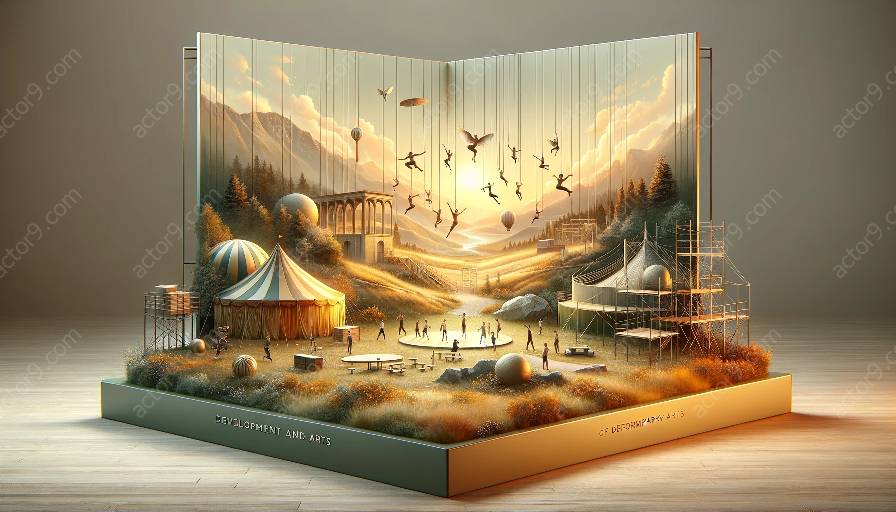Costume design and makeup play pivotal roles in the visual storytelling of circus performances. The intricate and elaborate costumes, along with the creative application of makeup, not only enhance the spectacle but also contribute to the development and training of circus arts. This topic cluster delves into the significance of costume design and makeup in circus performances, their impact on the development and training in circus arts, and the artistic and technical aspects involved.
The Aesthetics of Costume Design and Makeup in Circus Performances
Circus performances are renowned for their extravagant and vibrant visual displays, often characterized by flamboyant costumes and striking makeup. These elements serve as essential tools for creating larger-than-life characters, setting the mood, and capturing the audience's imagination. The aesthetics of costume design and makeup in circus performances are a fusion of artistry, storytelling, and spectacle, where every detail contributes to the overall narrative and atmosphere of the show.
Evoking Emotions and Themes
Costume design and makeup are powerful mediums for evoking emotions and expressing themes within circus performances. The choice of colors, textures, and styles in costumes, as well as the application of makeup techniques, can convey a wide range of emotions – from joy and excitement to mystery and intrigue. Additionally, the costumes and makeup often reflect the themes and narratives of the performance, immersing the audience in fantastical worlds and captivating storylines.
Character Development and Identity
Costumes and makeup are instrumental in shaping the identity of circus performers and their characters. Through the visual transformation facilitated by costumes and makeup, performers embody their roles and bring their characters to life. The elaborate designs and attention to detail in costumes and makeup contribute to character development, allowing performers to fully embrace their on-stage personas and enhance their theatrical presence.
Techniques and Skill Development
Behind the glamour and spectacle of circus performances, costume design and makeup entail a blend of technical proficiency and artistic innovation. The creation of circus costumes involves intricate tailoring, embellishments, and materials selection, while makeup application requires precise techniques and an understanding of facial anatomy. As such, the process of designing and crafting costumes, as well as applying makeup in the context of circus arts, provides valuable opportunities for skill development and artistic expression.
Incorporating Practical Considerations
Costume design and makeup in circus performances also involve practical considerations that contribute to the overall success of the show. The functionality and durability of costumes, alongside the comfort and mobility of performers, are essential factors that impact the design process. Likewise, makeup application techniques must account for the demands of live performance, such as sweat resistance and long-lasting wear, while also aligning with the visual aesthetic of the production.
Integration with Development and Training in Circus Arts
Costume design and makeup are integral components of the development and training in circus arts, offering insights into the multifaceted nature of performance preparation and creative expression. Within the context of circus arts, the incorporation of costume design and makeup extends beyond mere adornment, serving as educational tools that enhance the artistic and technical skills of circus performers.
Artistic Exploration and Collaboration
For aspiring circus artists, the exploration of costume design and makeup opens up avenues for artistic collaboration and experimentation. Engaging with costume designers and makeup artists provides valuable learning experiences, fostering an understanding of how visual elements contribute to the overall impact of a performance. This collaborative approach encourages creativity, teamwork, and an appreciation for the interdisciplinary nature of circus arts.
Professional Development and Industry Standards
Learning about costume design and makeup in the context of circus arts prepares individuals for the professional standards and expectations within the industry. The knowledge and practical skills acquired through training in costume design and makeup contribute to the well-rounded development of circus artists, equipping them with a comprehensive understanding of the visual aspects that complement their performance abilities.
Embracing Creativity and Innovation
Costume design and makeup in circus arts encourage a spirit of creativity and innovation, allowing for the exploration of new concepts, materials, and techniques. As the circus arts continue to evolve, the role of costume design and makeup remains adaptable and open to inventive interpretations. By embracing creativity and innovation, circus performers and creators can continually push the boundaries of visual storytelling and enhance the overall artistic landscape of circus arts.
Conclusion
Costume design and makeup hold a profound significance in the realm of circus performances, shaping the visual narratives and contributing to the immersive experience of audiences. In the context of development and training in circus arts, the exploration of costume design and makeup offers valuable insights into the artistic, technical, and collaborative dimensions of performance preparation. By understanding the intricate relationship between costume design, makeup, and circus arts, individuals can gain a holistic appreciation for the transformative power of visual elements in live entertainment.


































